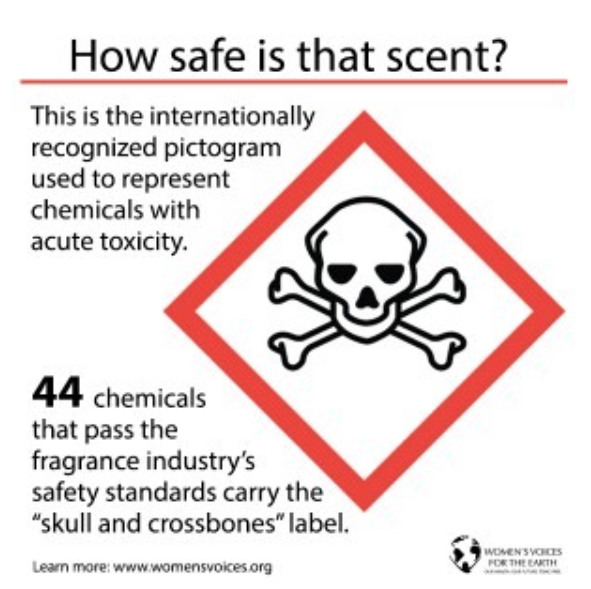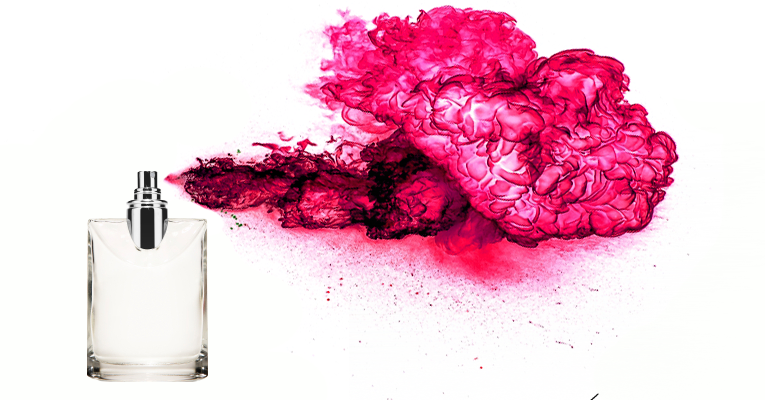Stop to think for a second about how many fragranced products you come into contact with every day. Whether it’s personal care products like shampoo, dishwashing liquid, laundry detergent, perfume, air fresheners, or candles, chances are you are exposed to at least a dozen products that contain fragrance on a daily basis. Unfortunately we are unknowingly being exposed to potentially hundreds of chemicals as a result, some of which are toxic to our health.
Considering we are exposed to fragranced products every day, even for those of us who deliberately don’t use it (we’ve all sat next to that woman or man on the plane who is wearing too much perfume or cologne or been accosted with the heavily scented dryer exhaust of a neighbor) it’s shocking that there are very little regulations addressing chemical ingredients in fragrance.
Companies claim the exact chemicals used in fragrance are a trade secret and therefore don’t have to be disclosed to the public. (Never mind that advances in reverse engineering can quite accurately deformulate fragrances and are often used by fragrance competitors, which makes that argument moot.) Instead, for products that bear an ingredient label, often the single word “fragrance” is used to denote the presence of scent. That single word can be deceiving, as a single listing of “fragrance” can be made up of hundreds of chemical ingredients.
In response to consumer demands for greater transparency, the International Fragrance Research Association (IFRA), an industry-backed trade group, has published a Transparency List of a whopping 3,000 chemicals used in fragrance. This gives us an idea of what may be in fragrance, but the fragrance ingredients are rarely disclosed on a product-specific level, leaving consumers completely in the dark.
The fox guarding the hen house.
What’s more, the safety of those 3,000 fragrance chemicals is not adequately evaluated by any governmental agency globally. Instead IFRA and their research arm, the Research Institute for Fragrance Materials (RIFM) have been trusted to self-regulate and to establish their own safety guidelines for the use of fragrance chemicals.
It’s an inherent conflict of interest for an industry to set their own safety guidelines. Our research has found that the “safety standards” set by the fragrance industry are incomplete, biased, and operate with a problematic lack of transparency which far better serves the financial interests of the fragrance industry than protects public health. The IFRA/RIFM safety program is essentially comprised of four main parts:
- Peer-reviewed science on fragrance chemicals
- Safety assessments conducted by an independent expert panel (REXPAN)
- A comprehensive database of toxicological data on fragrance chemicals
- IFRA standards determining allowable levels of fragrance chemicals to be used in products
On the face of it, this sounds pretty good. But the reality shows there are significant gaps and loopholes, leaving a program that is simply inadequate to protect public health. For example, most of the basic scientific studies on fragrance ingredients are conducted by fragrance manufacturers and have never been published in a peer-reviewed journal. The peer-reviewed science that RIFM refers to is comprised of review articles that often mention and rely upon the summary results of these unpublished studies. This means there is no peer review of laboratory practices, appropriate controls, levels of significance or any of the hallmarks of authoritative science, to ensure that the results of these studies have not been manipulated to serve the interests of the manufacturer conducting the testing.
The RIFM Expert Panel (REXPAN) is an independent panel of toxicologists called upon to review the safety of fragrance ingredients. Unfortunately though there is a noticeable omission of expert panel reviews of any fragrance chemicals that are controversial, such as phthalates, synthetic musks, styrene, and methyl eugenol. It’s not clear if REXPAN has ever been asked to conduct a review of these controversial chemicals or whether their reviews simply have never been made public. It appears the REXPAN can get away with this because they operate in relative secrecy with no public disclosure of meeting dates, agendas or minutes.
The comprehensive RIFM database does exist, and is apparently full of interesting and pertinent data on the safety of fragrance chemicals. Unfortunately, one must be a dues paying member of IFRA to gain access to the database. RIFM does offer a non-member subscription to the database for the low price of $20,000 per year, but even those requests must first be approved by an industry review panel.
Toxic chemicals in fragrance
The IFRA has established the IFRA Standards, a set of voluntary bans and restrictions imposed on 186 specific fragrance chemicals of concern. The Standards are a bold step for a self-regulating industry, but again, there are holes in this process too. Notably, there are no IFRA standards in place for many of the most controversial fragrance ingredients of concern. There are no restrictions in place for the use of the following known carcinogens: styrene, pyridine, or benzophenone. There are no restrictions on the use of phthalates. There are also no restrictions on the hormone-disrupting synthetic musks Galaxolide or Tonalide.
What’s more, the IFRA standards/Code of Practice are voluntary, with little to no compliance verification required. IFRA member companies must comply with IFRA standards to maintain their membership, but compliance with the standards only rarely must be proven.
 The strength of the industry’s safety program is also called into question when you consider that more than 100 of the chemicals on IFRA’s Transparency List can be found on authoritative lists of toxic chemicals around the world including:
The strength of the industry’s safety program is also called into question when you consider that more than 100 of the chemicals on IFRA’s Transparency List can be found on authoritative lists of toxic chemicals around the world including:
- California Proposition 65
- National Toxicology Program Report On Carcinogens
- International Agency for Research on Cancer
- EU Annex ii: Chemicals prohibited from cosmetics in the European Union
- Canadian Hotlist-Chemicals prohibited/restricted from cosmetics
- EU Chemicals of Very High Concern
- ChemSec SIN List
- Hazardous 100+ List
These chemicals have been prioritized for review by numerous governmental bodies due to their inherent toxicity– yet these same chemicals do not appear to be prioritized by the IFRA/RIFM safety program.
Bottom line: fragrance has received a free pass for far too long.
Need for policy and market solutions
There are several things that need to happen to help ensure the safety of fragrance ingredients:
- Federal and state legislation is needed that requires product-specific disclosure of fragrance ingredients.
- Federal and state legislation is needed that requires fragrance to meet an unbiased standard of safety. Senators Feinstein (D-CA) and Collins (R-ME) recently introduced the Personal Care Product Safety Act (S.1014) which seeks to more stringently regulate ingredients in cosmetics.* Unfortunately the bill continues to exclude fragrance from disclosure and therefore also excludes fragrances from safety substantiation requirements.
- Manufacturers should voluntarily disclose fragrance ingredients on a product-specific basis. Companies such as SC Johnson & Son, RB, and Clorox have already begun to disclose more fragrance ingredients.
- Manufacturers should develop and disclose their chemical screening processes, detailing how they ensure the safety of their products, including their fragranced products.
- Big retailers should “mind the store” and adopt comprehensive chemicals policies that include requirements for public disclosure of fragrance ingredients on a product-specific basis, both on product packaging and online. Both Target and Walmart encourage suppliers to disclose fragrance ingredients through their respective chemical policies. Walmart notes in their Sustainable Chemistry Implementation Guide that disclosure should include “full disclosure of all ingredients including those typically protected under trade secrets (e.g. fragrances).“
Without these protections in place we are left with an industry that keeps safety studies hidden from the public, avoids conducting safety assessments of some of the most high profile fragrance chemicals, and greenlights chemicals that reputable authoritative governmental bodies have deemed hazardous.
Does this sound like an industry you would trust to protect your health?
To read a full copy of my research report on fragrance, click here.
* Toxic-Free Future has not taken a formal position on the Personal Care Product Safety Act.




